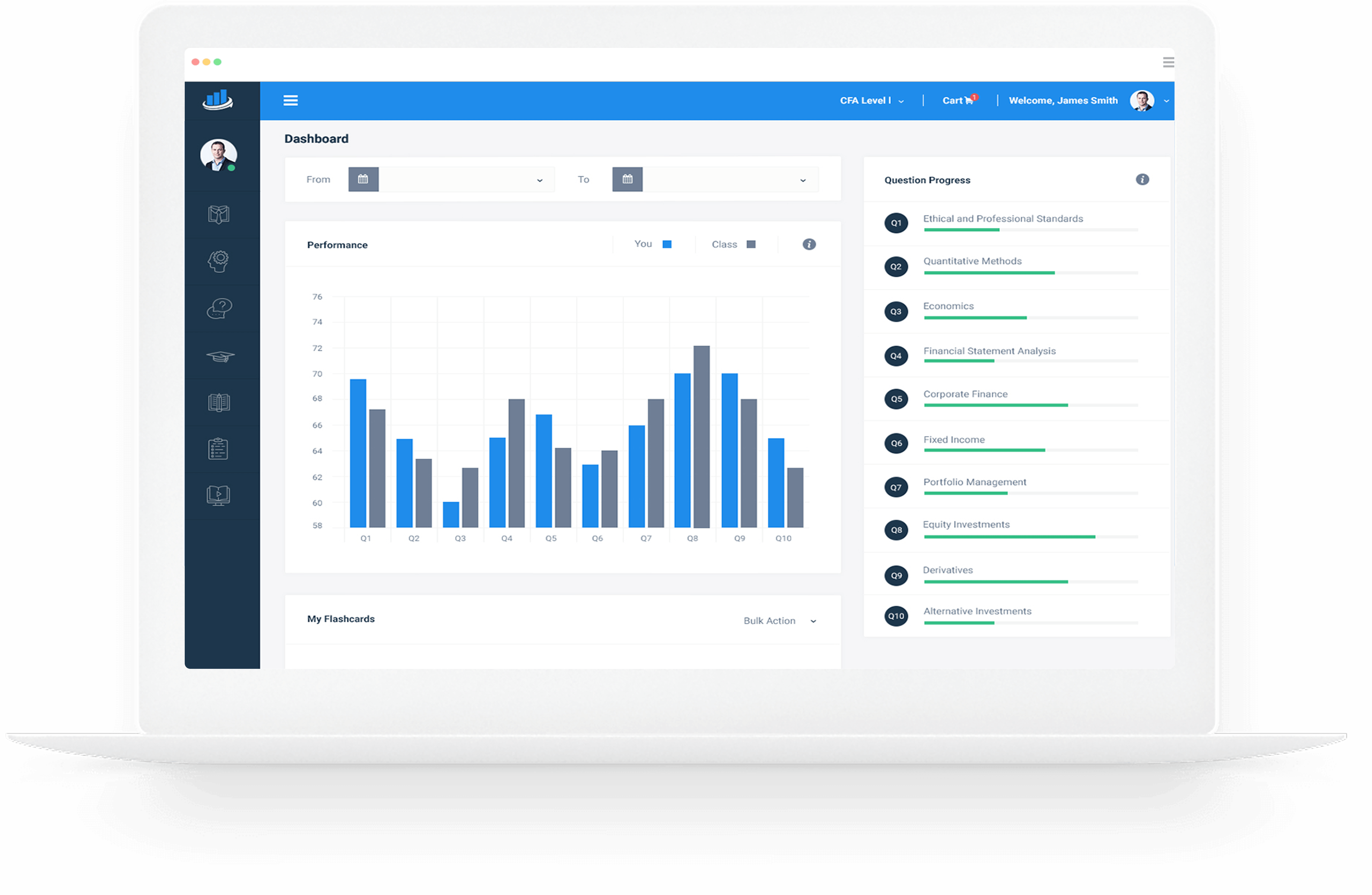Level III CFA® Program Practice Questions
Offered by AnalystPrep

How Different is the CFA Level II Exam?
The Level III CFA exam focuses mostly on portfolio management and wealth planning. However, candidates are also required to further their comprehension of the Code of Ethics and GIPS, along with understanding in depth all of the major asset classes, including fixed-income investments, equity investments, derivatives, and alternative investments. It is different from the other CFA exams because it requires candidates to have more descriptive knowledge and less calculation than the Level II CFA exam.
Level III CFA Exam Item Sets
For item set questions, candidates have to answer 6 questions from the same case, just like the Level II exam. AnalystPrep’s preparation platform further divides the Portfolio Management and Wealth Planning portion of the exam into different subcategories so candidates can identify their strengths and weaknesses and focus their studies on areas where they need the most work.
Get Started Right Away
All item sets from AnalystPrep’s Level III CFA Exam QBank are well organized by chapter and cover most of the important concepts that have been tested in past Level III CFA exams. Register a free account to test out 10 item sets (60 free questions) and see why AnalystPrep has helped thousands of candidates pass CFA exams!

Example Item Set from AnalystPrep's Level III CFA Exam Question Bank
High-Rise Investment Management (HRIM) is a Canadian asset management firm with a reputable standing in the financial community. Bill Coss is the head of the trading division at the firm and supervises more than twenty financial experts in his department. Due to an expansion in the firm’s business, Coss has recently hired a few portfolio managers to support the trading activities of the firm. One of the new employees is Bruce Block, an equity portfolio manager who worked for a small Canadian equity firm for two years. During his job interview, Coss mentioned the various types of orders traders use, which portfolio managers need to understand. Block made the following comments:
Statement 1: “A variation of the market order designed to give the agent of the trader greater discretion than a simple market order is the market-not-held order.
An order type that gives the trader’s agent even more discretion is the ‘best efforts order.’”
Statement 2: “Sometimes traders with a buying motive post bids, hoping others would sell to them, yielding negative implicit trading costs. However, if the bid-ask spread is small, they may buy at the ask. Such trading is termed a pegging strategy which typically utilizes iceberg orders.”
On his first day at work, Block was instructed by Coss to work with the firm’s most senior trader, Mike Gentile, to purchase 1,650 shares of Altec Corporation. The trade was executed in a single day and was split into three parts of different trade sizes. Exhibit 1 displays information about the dealers who make a market in Altec Corp’s stock and their quoted bid-ask prices. Exhibit 2 displays information about the three trades executed by Block.
| Dealer | Bid Price (C$) | Bid Size | Ask Price (C$) | Ask Size |
| Dealer A | 45.74 | 750 | 47.88 | 800 |
| Dealer B | 45.76 | 500 | 47.56 | 450 |
| Dealer C | 45.68 | 200 | 48.90 | 350 |
| Trade | Shares Bought | Execution Price (C$) |
| Trade 1 | 750 | 47.70 |
| Trade 2 | 500 | 47.56 |
| Trade 3 | 400 | 49.10 |
Dealer A’s quote was in effect at the time of trade 1, Dealer B’s quote was in effect at the time of trade 2, and Dealer C’s quote was in effect at the time of trade 3.
Coss came over to analyze the costs of the trade. After his analysis, he made the following comments:
Statement 3: “The inside bid-ask spread is lower than any individual dealer’s spread.”
Statement 4: “The average effective spread of Altec Corp’s stock transactions is C$2.4.”
Gentile works with many of the firm’s portfolio managers toward selecting the appropriate execution strategy for portfolio decisions. As a part of this process, Gentile assesses the execution of orders in three stocks. Exhibit 3 displays information in the order management system, including trade sizes, market attributes, and the urgency levels of the portfolio managers, for the three stocks.
| Stock | Size (shares) | Avg. Daily Vol. | Price | Spread (%) | Urgency |
| A | 15,000 | 45,000 | 65.78 | 0.45 | Low |
| B | 89,000 | 1,500,000 | 102.34 | 0.03 | Low |
| C | 47,000 | 1,000,000 | 39.02 | 0.02 | Low |
Gentile sold 500 shares of Star Energy Inc. for a pension fund at $50.00 per share. All the trades that occurred during the day in Star Energy Inc. are shown in Exhibit 4.
Shares traded in Star Energy Inc.
| Trade Price ($) | Shares Traded |
| 53.45 | 300 |
| 49.77 | 400 |
| 50.00 | 500 |
| 50.10 | 650 |
Coss is working with Gentile to rebalance his portfolio in order to keep the asset class weights within their specified corridors. Coss has specified a corridor for each asset class as a common multiple of the standard deviation of the asset class’s returns.
Gentile is determining the appropriate execution strategy for the stock of Pyramid Enterprise, a thinly traded stock with irregular volume patterns. He has decided to use a simple logical participation strategy but is unsure which one to use.
Practice Questions
Question 1/6
Block is least accurate with respect to:
A. Statement 1 only.
B. Statement 2 only.
C. neither Statement 1 nor Statement 2.
The correct answer is C.
Statement 1 is correct. A market-not-held order gives the agent of a trader greater discretion than a simple market order since the broker is not required to trade at any specific price or time interval, as would be required with a simple market order. A ‘best efforts order’ gives the agent even more discretion to work the order only when the agent judges market conditions to be favorable.
Statement 2 is correct. A pegging strategy is an opportunistic strategy in which the trader who wishes to buy posts a bid, hoping others will sell to him or her, yielding negative implicit trading costs. If the bid-offer spread is small, the trader might buy at the ask. This strategy involves using iceberg orders, also called reserve or hidden orders, and crossing to provide additional sources of liquidity at a low cost.
Question 2/6
Coss is most accurate with respect to:
A. Statement 3 only.
B. Statement 4 only.
C. both statements 3 and 4.
The correct answer is B.
Statement 3 is incorrect. Inside bid-ask spread is the lowest ask less the highest bid = 47.56-45.76 = $1.8, which is equal to Dealer B’s spread.
Statement 4 is correct. For trade 1, the midpoint of the market at the time the order is entered (which are the quotes of Dealer A) is equal to 45.74+47.88/2 = 46.81
The effective spread = 2×(47.70-46.81) = $1.78
For trade 2 the effective spread is 2×(47.56-46.66)=$1.8
For trade 3, the effective spread is 2×(49.10-47.29) = $3.62
The average effective spread is 1.78+1.8+3.62/3 = $2.4
Question 3/6
Which of the following is most accurate about the orders in the Order Management System?
A. The order in Stock A is most suited for a VWAP algorithm, and the order in Stock B should be traded using an implementation shortfall algorithm.
B. The orders in Stock B and C are most suited for a logical participation strategy, whereas the order in Stock A should be traded on a crossing system.
C. The order in Stock B should be traded on a crossing system, whereas the order in Stock C is most suitable for trading through a broker.
The correct answer is B.
Orders as a percentage of average daily volume:
A: 15,000/45,000 = 0.33
B: 89,000/1,500,000 = 0.0593
C: 47,000/1,000,000 = 0.047
The order in Stock A is large relative to the average daily volume, has a large spread and a low urgency, so it should most likely be traded using a broker or a crossing system.
The orders in Stocks B and C are small relative to their average daily volumes, have low spreads, and have low urgencies. Hence, they are suited for algorithmic execution, probably with a VWAP algorithm or other simple logical participation strategies.
Question 4/6
The implicit transaction cost of the trade in Star Energy Inc., using the VWAP as the price benchmark, is closest to:
A. $212.39
B. $230.95
C. $272.43
The correct answer is C.
VWAP = dollar volume/trade volume
Dollar volume = (300×53.45) + (400×49.77) + (500×50) + (650×50.10) = 93,508
Trade volume = 300+400+500+650 = 1,850
VWAP = 93,508/1,850 = 50.545
Implicit costs = 500 × ($50.545-$50) = $272.43
Question 5/6
Which of the following is most accurate about the rebalancing strategy that Coss is using for his own portfolio?
A. Each asset class will have a different probability of triggering rebalancing if the normal distribution describes the asset class returns.
B. The rebalancing strategy does not account for differences in transaction costs or asset correlations.
C. Such a strategy requires less frequent rebalancing when the market is trending and more frequent rebalancing when the market is characterized by reversals.
The correct answer is B.
The rebalancing strategy used by Coss is an equal probability rebalancing strategy. In this discipline, each asset class is equally likely to trigger rebalancing if the normal distribution describes asset class returns. Also, equal probability rebalancing does not account for differences in transaction costs or asset correlations. Option C describes tactical rebalancing, a variation of calendar rebalancing that specifies less frequent rebalancing when markets appear to be trending and more frequent rebalancing when they are characterized by reversals.
Question 6/6
Which of the following simple logical participation strategy will be most appropriate for trading in Pyramid Enterprise’s stock?
A. TWAP.
B. VWAP.
C. Percentage of volume strategy
The correct answer is A.
The TWAP strategy breaks up the order over the day in proportion to the time and hence, is useful in thinly traded assets whose volume patterns might be erratic. Since the above traits characterize the stock of Pyramid Enterprise, the TWAP (time-weighted average price) strategy would be most appropriate.
Level III of the CFA® Exam
AnalystPrep’s practice packages for Level III of the CFA exam start as low as $249 with a 12-month access.
Level III of the CFA Exam - Practice Package by AnalystPrep
$
249
/ 12-month access
- Question Bank (Item Sets)
- Essay-Type Questions
- Performance Tracking Tools
- 5 Ask-A-Tutor Questions













